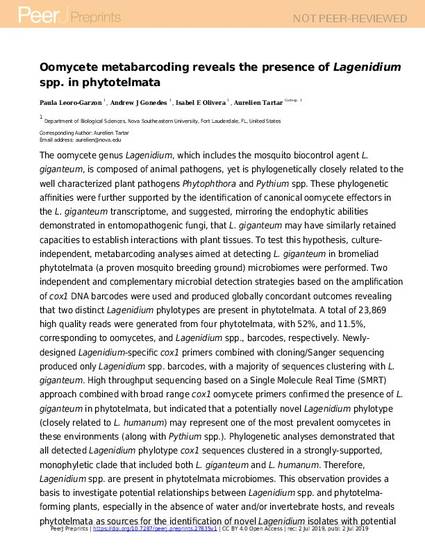
Article
Oomycete Metabarcoding Reveals the Presence of Lagenidium spp. in Phytotelmata
PeerJ Preprints
Document Type
Article
Publication Date
7-2-2019
Keywords
- Biodiversity,
- Genomics,
- Microbiology,
- Molecular biology,
- Mycology,
- Metagenomics,
- Oomycete,
- DNA barcode,
- Plant axils
Disciplines
- Biology and
- Life Sciences
Abstract
The oomycete genus Lagenidium, which includes the mosquito biocontrol agent L. giganteum, is composed of animal pathogens, yet is phylogenetically closely related to the well characterized plant pathogens Phytophthora and Pythium spp. These phylogenetic affinities were further supported by the identification of canonical oomycete effectors in the L. giganteum transcriptome, and suggested, mirroring the endophytic abilities demonstrated in entomopathogenic fungi, that L. giganteum may have similarly retained capacities to establish interactions with plant tissues. To test this hypothesis, culture-independent, metabarcoding analyses aimed at detecting L. giganteum in bromeliad phytotelmata (a proven mosquito breeding ground) microbiomes were performed. Two independent and complementary microbial detection strategies based on the amplification of cox1 DNA barcodes were used and produced globally concordant outcomes revealing that two distinct Lagenidium phylotypes are present in phytotelmata. A total of 23,869 high quality reads were generated from four phytotelmata, with 52%, and 11.5%, corresponding to oomycetes, and Lagenidium spp., barcodes, respectively. Newly-designed Lagenidium-specific cox1 primers combined with cloning/Sanger sequencing produced only Lagenidium spp. barcodes, with a majority of sequences clustering with L. giganteum. High throughput sequencing based on a Single Molecule Real Time (SMRT) approach combined with broad range cox1 oomycete primers confirmed the presence of L. giganteum in phytotelmata, but indicated that a potentially novel Lagenidium phylotype (closely related to L. humanum) may represent one of the most prevalent oomycetes in these environments (along with Pythium spp.). Phylogenetic analyses demonstrated that all detected Lagenidium phylotype cox1 sequences clustered in a strongly-supported, monophyletic clade that included both L. giganteum and L. humanum. Therefore, Lagenidium spp. are present in phytotelmata microbiomes. This observation provides a basis to investigate potential relationships between Lagenidium spp. and phytotelma-forming plants, especially in the absence of water and/or invertebrate hosts, and reveals phytotelmata as sources for the identification of novel Lagenidium isolates with potential as biocontrol agents against vector mosquitoes.
Additional Comments
USDA Agriculture and Food Research Initiative grant #: 2011-68004-30104; US Department of Education Minority Science and Engineer Improvement Program grant #: P120A140012
DOI
10.7287/peerj.preprints.27835v1
Citation Information
Paula Leoro-Garzon, Andrew J. Gonedes, Isabel Olivera and Aurelien Tartar. "Oomycete Metabarcoding Reveals the Presence of Lagenidium spp. in Phytotelmata" PeerJ Preprints (2019) p. e27835v1 ISSN: 2167-9843 Available at: http://works.bepress.com/aurelien-tartar/50/

©2019 Leoro-Garzon et al. This is an open access article distributed under the terms of the Creative Commons Attribution License, which permits unrestricted use, distribution, reproduction and adaptation in any medium and for any purpose provided that it is properly attributed. For attribution, the original author(s), title, publication source (PeerJ Preprints) and either DOI or URL of the article must be cited.